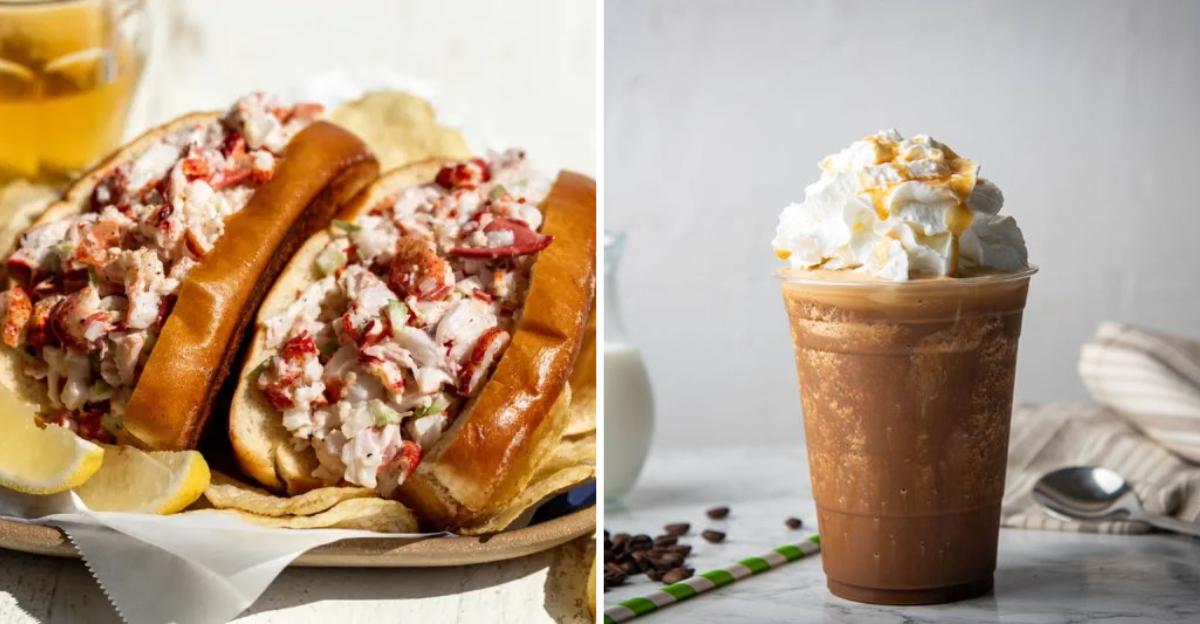14 Massachusetts Dishes Locals Refuse To Let Anyone Criticize

Massachusetts kitchens have been turning out iconic dishes for generations, weaving them into the fabric of the state’s cultural identity.
From fresh, briny seaside classics like clam chowder and fried clams to decadent sweet treats perfected in small-town bakeries, these foods are more than just meals—they’re traditions, memories, and sources of community pride.
Each bite tells a story of heritage and local flavor, passed down through families and neighborhoods. And when outsiders dare to criticize these beloved staples, Bay Staters don’t just shrug it off—they rise to the defense with a passion that borders on fierce devotion, protecting flavors they hold dear.
1. New England Clam Chowder
Manhattan’s red version might exist elsewhere, but real Bay Staters know white is the only acceptable chowder color. I’ve watched my grandfather stir his steaming pot of chowder with the same wooden spoon for thirty years, insisting the flavor lives in that well-seasoned utensil.
The creamy base should be velvety but never thick enough to stand a spoon in – that’s tourist chowder. Tender clams, diced potatoes, and just enough salt pork provide the foundation for this centuries-old comfort food.
Order it in any Massachusetts seafood joint and watch how seriously they take this seemingly simple soup. The debate over adding corn may divide families, but everyone agrees: tomatoes are absolutely forbidden.
2. Boston Cream Pie
Golden sponge cake embracing vanilla custard with a glossy chocolate ganache hat – the Boston Cream Pie has been making Massachusetts mouths happy since 1856. My aunt brings one to every family gathering, and nobody dares suggest store-bought as an alternative.
Born at the Parker House Hotel downtown, this cake-disguised-as-pie became our official state dessert in 1996. The perfect slice should have equal parts cake and custard, with chocolate that shatters slightly when your fork breaks through.
Locals judge bakeries primarily on their Boston Cream execution. A dry cake or runny custard? Unforgivable culinary crimes that can sink a reputation faster than tea into Boston Harbor.
3. Fenway Franks
Baseball and hot dogs go together everywhere, but Fenway Franks transcend mere ballpark food to become part of the Red Sox experience. I’ve eaten them in sunshine and rain, victory and defeat, and somehow they always taste like summer hope.
Steamed to perfection and nestled in New England-style split-top buns (grilled with butter on both sides, naturally), these hot dogs have a distinctive snap when you bite into them. The secret lies in the proprietary blend of spices and the atmosphere of America’s oldest ballpark.
Locals don’t just eat Fenway Franks – they participate in a ritual that connects generations of Sox fans through the simple pleasure of a perfectly dressed dog.
4. Lobster Roll
Summer in Massachusetts isn’t complete without at least one proper lobster roll. The first time I brought an out-of-state friend to my favorite seaside shack, she gasped at the price – then fell silent with the first buttery bite.
The debate between hot with butter (Connecticut-style) versus cold with mayo (Maine-style) rages on, but most Massachusetts natives lean toward the warm, buttered version. Fresh-picked lobster meat should overflow from a top-split, toasted New England hot dog bun.
Restaurants that skimp on lobster or – heaven forbid – use frozen meat face the collective scorn of locals who can taste the difference between lobster caught that morning and yesterday’s catch.
5. Boston Baked Beans
There’s a reason they call us Beantown. These molasses-sweetened navy beans, slow-cooked until they develop a caramelized crust, represent centuries of Saturday night tradition. My grandmother’s bean pot had permanent residence in her oven, producing beans so good they made Sunday morning leftovers better than most breakfast foods.
The classic recipe includes salt pork, onions, and a touch of mustard powder. Native Americans taught early settlers this cooking method, using maple syrup instead of molasses.
True Massachusetts baked beans require patience – at least six hours of gentle heat to transform simple ingredients into something transcendent. Rushing the process is considered culinary sacrilege by bean purists throughout the Commonwealth.
6. Fluffernutter Sandwich
Marshmallow Fluff was born in Somerville in 1917, and Massachusetts kids have been combining it with peanut butter ever since. I packed these sticky sandwiches for school lunch so often that my classmates from other states thought I was slightly weird – until I convinced them to try one.
The perfect Fluffernutter requires white bread (no artisanal substitutions allowed), smooth peanut butter spread to the edges, and a generous dollop of Fluff that oozes with each bite. Some families add banana slices or a drizzle of honey, but purists consider these unnecessary embellishments.
The sandwich became so culturally significant that legislators once attempted to make it the official state sandwich.
7. Cranberry Anything
Massachusetts produces the second-most cranberries in America, and we proudly incorporate these tart ruby gems into everything imaginable. Growing up near the bogs, fall meant watching the harvest floods transform fields into floating red berries – a sight that still stops traffic on Cape Cod.
Cranberry sauce isn’t just for Thanksgiving here – it’s a year-round condiment. Local chefs create cranberry chutneys, jams, relishes, and even cranberry-infused meats that showcase our agricultural pride.
The most heated local food arguments often center around homemade versus canned cranberry sauce, with family Thanksgiving tables sometimes featuring both to maintain peace. Suggesting cranberries aren’t worth the fuss might get you uninvited from holiday gatherings altogether.
8. Portuguese Sweet Bread
In southeastern Massachusetts, where Portuguese immigration shaped local culture, this slightly sweet, pillowy bread with its distinctive glossy crust has become a regional treasure. My Portuguese neighbor would bring still-warm loaves to welcome new families to our street – the ultimate gesture of community.
Traditional bakers insist on using lemon zest and a touch of cinnamon to create the subtle flavor that makes this bread perfect for morning toast or afternoon tea. The eggy dough creates a rich yellow crumb that stays moist for days.
During Easter and Christmas, special versions appear with decorative braids and colorful eggs baked into the top. Suggesting store-bought alternatives to a family with Portuguese roots might earn you a look that could curdle milk.
9. Fried Clams
Lawrence “Chubby” Woodman invented fried clams in Essex in 1916, forever changing summer dining along the Massachusetts coast. Standing in line at the clam shack, sand still between my toes from the beach, remains one of life’s perfect moments.
Whole belly clams – not strips – are the only acceptable version for serious local seafood lovers. The sweet, briny bellies should be encased in a light, crispy cornmeal coating that shatters when bitten, never greasy or heavy.
Served in paper-lined baskets with lemon wedges, tartar sauce, and maybe a side of onion rings, proper fried clams taste like Massachusetts summer distilled into a single, perfect bite. Outsiders who prefer clam strips are politely but firmly educated about their error.
10. Roast Beef Three-Way
North Shore roast beef sandwiches inspire the kind of loyalty usually reserved for sports teams. The “three-way” – thinly sliced rare roast beef on an onion roll with James River BBQ sauce, mayo, and American cheese – has fueled late-night cravings for generations.
My college roommates and I would drive 30 miles at midnight just to hit Kelly’s or Nick’s for these messy, magnificent creations. The beef must be rare enough to maintain a pink center, sliced paper-thin, and piled so high it seems structurally impossible.
Every North Shore town has a beloved beef joint that locals swear makes the only authentic version. Suggesting improvements to someone’s favorite roast beef sandwich recipe might be the fastest way to start an argument in Essex County.
11. Scrod
Ask ten Massachusetts residents what exactly “scrod” is, and you’ll get eleven different answers – but everyone agrees it’s delicious. Generally understood to be young cod or haddock, this mild white fish appears on virtually every traditional restaurant menu across the state.
My grandfather claimed the name came from “sacred cod,” honoring the fish that built Massachusetts’ economy. Others insist it stands for “small cod recently off dock.” Whatever its origins, scrod typically arrives broiled with butter and breadcrumbs or baked with lemon and herbs.
The freshness matters more than the preparation – true Massachusetts scrod should have been swimming that morning. Visitors who question why we’re so passionate about such a simple dish clearly don’t understand our maritime heritage.
12. Frappes
Don’t call it a milkshake unless you want to reveal yourself as an outsider. In Massachusetts, a frappe (pronounced “frap”) is the thick, creamy blend of ice cream and milk that other states mistakenly call a milkshake. I learned this distinction the hard way after moving briefly to New York and receiving plain milk with flavoring when ordering a “milkshake.”
A proper frappe should be thick enough to require both a straw and a spoon. The best versions come from old-school ice cream stands that use local dairy and hand-packed ice cream.
Coffee frappes reign supreme in this Dunkin’-dominated state, though chocolate, vanilla, and seasonal flavors like pumpkin have their devoted followers too.
13. Bar Pizza
South Shore bar pizza bears little resemblance to New York or Chicago styles – and locals wouldn’t have it any other way. These individual-sized pizzas feature a thin, crispy crust that extends right to the edge of the pan, creating the signature lacy, charred rim.
My father would bring home these special pies every Friday night, each in its own cardboard plate with that unmistakable blend of cheese stretching across the top. The true test of authentic bar pizza is whether it can be turned upside down without toppings falling off.
Ordering a “laced” pie brings an extra layer of cheddar atop the traditional mozzarella blend. Attempts to gourmet-ify this humble creation are met with the special disdain Massachusetts reserves for fixing what isn’t broken.
14. Indian Pudding
Colonial-era Massachusetts cooks, missing their English puddings but lacking wheat flour, created this uniquely American dessert using cornmeal, molasses, and milk. My first taste came during a fourth-grade field trip to Plimoth Plantation, where I discovered its earthy sweetness was nothing like the pudding cups in my lunch box.
Slow-baked until dark and caramelized, with a texture somewhere between custard and cake, Indian pudding embodies Massachusetts’ practical approach to comfort food. Cinnamon, ginger, and nutmeg provide warm spice notes that complement the deep molasses flavor.
Traditionally served warm with vanilla ice cream melting into its depths, this historic dessert remains on menus at old-school restaurants where locals go for a taste of the past.
